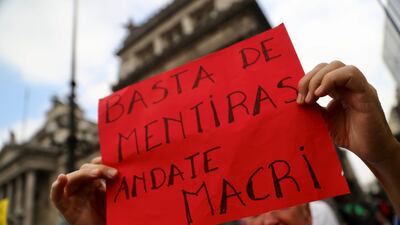The relationship between developed and emerging market equities has broken down and, by some measures, the fracture hasn't been this deep in over 20 years.
The question now is whether emerging markets recover and catch up with their developed peers, or does the turmoil that has engulfed EM this year finally spill over into developed markets, too? While there's a case to be made that emerging stocks are close to bottoming - they're in a bear market, after all - investors are in no rush to get back in yet. The crises in Argentina and Turkey suggest that caution is warranted.
In which case, developed world stocks are vulnerable.
The simple monthly correlation between the MSCI benchmark emerging index and the S&P 500 was running at 0.38 last week, the lowest since April 1996. It has halved since January, when it hit a four-year high of 0.76.
A reading of 1.0 indicates the strongest possible correlation between two assets or markets, and minus 1.0 the strongest possible inverse correlation.
The breakdown really became evident around May. Events in Argentina and Turkey, coupled with deepening weakness in China as trade war tensions escalated, sent emerging markets into a tailspin, while Wall Street got its mojo back in large part thanks to a recovery in tech.
A similar weakening of this correlation also emerged in 2014-15, culminating in a fall to 0.48 in July 2015. At that time, it was the lowest since 1997. The MSCI emerging benchmark was already in a bear market then and continued to decline into early 2016, its losses over the period totalling around 35 percent. What Wall Street did next is instructive.
The S&P 500 had held up strongly but finally buckled in August 2015, falling 10 per cent in a matter of weeks before recovering. A few months passed before it buckled again, sliding another 15 per cent in early 2016.
Will history repeat itself this time around?
Much might depend on the dollar. Its rally this year, together with the rise in US interest rates and bond yields, has hammered emerging markets, which have large exposure to dollar-denominated funding.
_______________
Read more:
The taxing problem of how to avoid another financial crisis
Trade wars and falling Iran exports to impact supply and demand, says Opec
_______________
Analysts at Deutsche Bank reckon the dollar is the most overvalued currency in the world right now. A pullback might ease the pressure on emerging equities, while bold investors might be tempted back into EM stocks by cheap valuations.
But the downside for emerging equities could still have further to run. According to fund flows tracker EPFR, cumulative flows into emerging equity funds topped $100 billion early this year, the highest since 2013. That has begun to reverse in recent months, but there's scope for much more profit-taking.
"We acknowledge emerging market equities have already underperformed over the last few months, but think it is too early to increase exposure again yet," Barclays analysts say.
Analysts at Goldman Sachs are more optimistic. They had long emerging equities as one of their top trade recommendations at the start of the year, targeting the MSCI emerging benchmark index at 1,250 points.
This week the index fell below 1,000 points, putting it deeper into undervalued territory, an estimated 5 per cent off the relative valuation cycle low of January 2016 which Goldman reckons marks a "significant" floor.
Meanwhile, the US economy, profits and stock markets are booming relative to the emerging world and indeed the rest of the world in general. But the likelihood grows that this spurt, nearly a decade into the economic and market recovery, is running on late-cycle fumes and the recent fiscal boost.
According to Fathom Consulting, the chances of a US recession by the end of 2019 will be as high as they have been in more than 60 years.
Although not everyone buys into it, the US yield curve barely 20 basis points from inverting strongly suggests the economy is set to slow. And history shows curve inversion heralds recession, always.
"Eventually the fiscal stimulus will fade. We know that's a one-off, the boost to GDP is a one-off, and the boost to earnings is a one-off. It will fade," said JP Morgan's Nikolaos Panigirtzoglou.
It can only be a matter of time before Wall Street begins to price in the reversal.
Reuters

